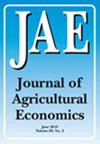中国宽带村试点项目对农户消费模式的影响评估
IF 4.2
2区 经济学
Q1 AGRICULTURAL ECONOMICS & POLICY
引用次数: 0
摘要
鉴于中国约一半的人口居住在农村地区,有必要评估中国在这些地区大量投资宽带基础设施的经济影响。我们使用2014年在中国西部启动的“宽带村”试点项目作为外生冲击来估计更好的高速互联网基础设施与农村消费之间的联系。我们依靠《中国家庭金融调查》中的农村家庭数据和一个差中差模型来评估宽带村倡议对家庭消费模式的影响。我们的研究结果表明,该计划的推出提高了基本需求和非必需品的支出,有助于促进农村消费,并间接促进中国西部地区的经济增长。我们还发现,试点在刺激消费方面的作用受到对信息的关注程度的调节,并且它不成比例地使年轻消费者和流动性严重受限的家庭受益。我们的分析强调了鼓励进一步发展基于互联网的销售模式的重要性,并在设计通过刺激消费促进增长的政策时考虑更广泛的社会经济背景。本文章由计算机程序翻译,如有差异,请以英文原文为准。
Assessing the Impact of China's Broadband Village Pilot Project on the Consumption Patterns of Rural Households
Given that rural areas are home to approximately half of China's population, it is essential to assess the economic impact of the country's substantial investment in broadband infrastructure in these regions. We use the ‘Broadband Village’ pilot project launched in western China in 2014 as an exogenous shock to estimate the link between better high‐speed internet infrastructure and rural consumption. We rely on data on rural households from the China Household Finance Survey and a difference‐in‐differences model to assess the impact of the Broadband Village initiative on household consumption patterns. Our results suggest that the program's launch has led to higher spending on both basic needs and non‐essential items, helping to boost rural consumption and indirectly promote economic growth in China's western regions. We also find that the pilot's role in stimulating consumption is moderated by the degree of attention to information, and that it has disproportionately benefited younger consumers and households with significant liquidity constraints. Our analysis underscores the importance of encouraging further development of internet‐based sales models and considering the broader socio‐economic context when designing policies to promote growth by stimulating consumption.
求助全文
通过发布文献求助,成功后即可免费获取论文全文。
去求助
来源期刊

Journal of Agricultural Economics
管理科学-农业经济与政策
CiteScore
7.90
自引率
2.90%
发文量
48
审稿时长
>24 weeks
期刊介绍:
Published on behalf of the Agricultural Economics Society, the Journal of Agricultural Economics is a leading international professional journal, providing a forum for research into agricultural economics and related disciplines such as statistics, marketing, business management, politics, history and sociology, and their application to issues in the agricultural, food, and related industries; rural communities, and the environment.
Each issue of the JAE contains articles, notes and book reviews as well as information relating to the Agricultural Economics Society. Published 3 times a year, it is received by members and institutional subscribers in 69 countries. With contributions from leading international scholars, the JAE is a leading citation for agricultural economics and policy. Published articles either deal with new developments in research and methods of analysis, or apply existing methods and techniques to new problems and situations which are of general interest to the Journal’s international readership.
 求助内容:
求助内容: 应助结果提醒方式:
应助结果提醒方式:


